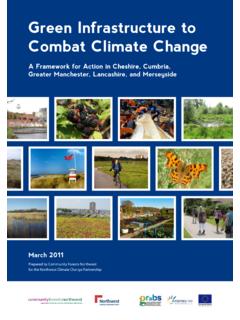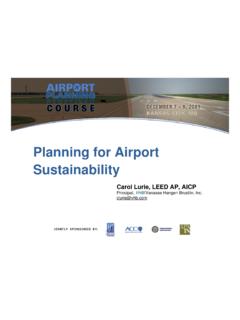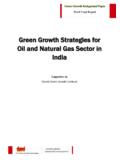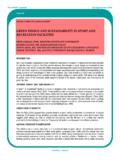Transcription of Towards a Green Infrastructure Framework for …
1 Towards a Green Infrastructure Framework for Greater manchester : Full Report ECOLOGY. STEWARDSHIP. ENVIRONMENTAL PLANNING. LANDSCAPE & URBAN DESIGN. ENVIRONMENTAL STRATEGIES. A Report by: TEP. Date: Sep 2008. CONTENTS PAGE. 1 INTRODUCTION ..1. 2 WHY IS A Green Infrastructure APPROACH ESSENTIAL? ..3. 3 THE VOCABULARY OF Green Infrastructure ..8. 4 Green Infrastructure OBJECTIVES FOR THE CITY REGION ..12. 5 GROWTH IN GREATER manchester : THREATS AND CHALLENGES..14. 6 THE RIGHT Green Infrastructure APPROACH FOR THE CITY- REGION?..21. 7 PLANNING FOR Green Infrastructure ASSETS.
2 26. 8 PLANNING FOR Green Infrastructure FUNCTIONS ..38. 9 A SPATIAL Framework FOR Green 10 Green Infrastructure IN LOCAL DEVELOPMENT Framework ..64. 11 INCORPORATING Green Infrastructure INTO RELEVANT CITY- REGIONAL PLANS, STRATEGIES AND 12 CASE 13 NEXT STEPS IN A CITY-REGIONAL APPROACH TO Green . Infrastructure ..92. Maps (Large Scale). Figure Urban Morphology Types Figure Land Designations Figure Urban Greenspaces, Civic Spaces and Waterways Figure Accessible Urban Greenspaces, Civic Spaces and Waterways Figure Greenways and Blue Infrastructure Figure Sustainable Movement Network Figure Natural and Landscape Heritage Core Areas Figure Urban Green Figure Strategic Flood Risk Assessment Figure Flood Management Function Figure Health Deprivation Towards a Green Infrastructure Framework for Greater manchester Final Report September 2008.
3 Figure Percentage of Population Aged 65 and Over Figure Surface Temperatures Figure Climate Adaptation Function Urban Heat Vulnerability Figure Climate Adaptation Function Carbon Storage Figure Deficiencies of Accessible Urban Green Infrastructure Figure Sustainable Movement Network in relation to Economic Centres Figure Place-Making Function Figure Image-Making Function Figure Regeneration Function Figure GI and Distinctive Places Key Diagram Figure GI for an Urban Renaissance Key Diagram Figure GI for Sustainable Movement Key Diagram Figure GI in a Changing Climate Key Diagram GI Figure Greater manchester Green Infrastructure Framework to Support Growth Towards a Green Infrastructure Framework for Greater manchester Final Report September 2008.
4 1 INTRODUCTION. Greater manchester is committed to growth and has a vision of a vibrant modern economy, with communities enjoying a high quality of life; underpinned by a healthy and attractive natural environment. Its aspirations for growth are shared by Government; and in July 2008 Greater manchester was declared as a New Growth The City-Region was at the forefront of the Industrial Revolution, but the negative environmental and social legacies of unsustainable growth through the 19th and 20th centuries has left many communities deprived of high quality open space and has fragmented urban river ecosystems.
5 This in turn leaves many neighbourhoods vulnerable to flooding. The City-Region knows that, unless the natural environment is protected and allowed to function effectively, growth risks being unsustainable, and short-lived. Areas which have undergone decline in environmental and social quality are now the focus of aspirational growth and redevelopment. The challenge is threefold: a. to reverse the legacy of past decline;. b. to create a setting for growth;. c. to make the City Region's natural environment resilient to meet the demands of population growth and climate change.
6 A healthy natural environment is a pre-requisite of growth the social and economic benefits that high environmental quality brings are well-documented. A. strategy for growth requires a positive plan for Green Infrastructure . The use of the term Infrastructure underlines that this is a function-oriented approach to planning. The City-Region's outdoor environments provide the places where growth-support functions can occur, including: a. managing surface waters and reducing flood risk;. b. adapting urban environments for climate change resilience;. c. inspiring inward investment and retention of high-value workers and entrepreneurs d.
7 Enabling healthy activity, recreation and social cohesion;. e. regenerating areas experiencing (actual or incipient) deprivation;. f. sustaining jobs in the natural economy;. g. maintaining and enhancing distinctive biodiversity, landscape and heritage;. h. enabling sport and cultural excellence. Many of these functions overlap; and many places can or should deliver several of these functions a Green Infrastructure approach will ensure the City-Region's outdoor environment is multi-functional, accepting there are some sensitive ecosystems which might be damaged by inappropriate public access.
8 1. Communities and Local Government (2008): Second Round Growth Points Partnership for Growth proposes 67,500. new homes between 2008 and 2017. Towards a Green Infrastructure Framework for Greater manchester 1. Final Report September 2008. Aim and Objectives TEP was commissioned by AGMA and Natural England to advise how Green Infrastructure (GI) might be embedded into the City-Region's spatial planning policy and practice; in order to enable and sustain growth. In simple terms, this report aims to provide AGMA with a route-map for a Greater manchester approach to GI planning.
9 The commission had several objectives: a. To define GI in language relevant to the City-Region (see Chapter 3);. b. To describe the City-Region's existing GI (see Chapter 7);. c. To identify priority areas for of GI in the City Region(see Chapters 8 . d. To advise how GI principles and practice can be incorporated into the above documents, specifically advising on how GI policy can be included in emerging Local Development Frameworks (see Chapter 10);. e. To highlight specific plans, strategies and programmes which need to incorporate GI principles and practice (see Chapter 11).)
10 F. To assess case studies of how GI is planned and delivered in other mature urban areas (see Chapter 12);. g. To recommend next steps in the development of a City-Region -wide approach to GI (see Chapter 13). Prior to commissioning TEP, AGMA and the Red Rose Forest had identified a provisional set of City-wide priorities for GI and had assembled GIS datasets illustrating GI resources. The commission was guided by a project Steering Group and a wider group of consultees consisting of GM-wide bodies and Forward Planners in constituent Local Authorities. During the commission, the Government confirmed New Growth Point status and affirmed the importance of a Green Infrastructure approach (see box).





